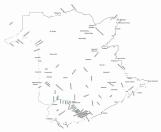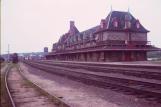1
In 1864 the New Brunswick Government passed the "Lobster Act". This act also provided money for the construction of several small spur lines in the Province but was mainly designed to entice private enterprise to complete a rail line to connect Maine with the European & North American line in Saint John. This line would provide manufacturers in New Brunswick with an efficient way to move goods to American markets. Another reason for building the line was that when connected with a line to Halifax the line could be used to cut down on the travel time for passengers coming from Europe by ship. Passengers could get off at Halifax and travel the rest of the way to Central Canada and the United States by rail. A group of investors led by Saint John businessman William Parks decided to take up the challenge, but rather than build the line directly to Calais Maine along the proposed European & North American route, this line would instead be built up the St. John River in order to tap into the growing markets of that area. This route may have been chosen because of political pressure to open the line into Northern Maine. Construction began in 1867 and by 1868 the line was completed from Saint John to Westfield Beach. A year later the line was completed from Saint John through Fredericton Jct. to McAdam. When the Maine section of the line built by the Maine Central Railway was completed in 1871 New Brunswickers at last had a rail connection with the United States and Central Canada (through the United States) to transport freight and passengers. The problem was that the Maine Central Railway was built with a different gauge than the railways in New Brunswick and the Grand Trunk line from Montreal to Portland. That meant that freight had to be unloaded and loaded onto another train twice between Saint John and Montreal. This delay meant that cargo could move by ship just as fast as by rail between those cities. The line suffered from other problems, American free trade policies of the 1850's had expired and the line did not connect with the communities along the St. John River. In 1878 the Saint John and Maine Railway Company purchased the line for $37,000. That same year the John A. MacDonald government brought in its National Policy of high tariffs to promote Canadian manufacturing. This policy hurt the Western extension which was built to help promote trade between the United States and the Maritimes Provinces. Another problem for the line was that it was not built along the St. John River, instead it was built to the west of communities along the St. John River. This meant that the line was not close enough for producers along the St. John River to use the railway. The line was purchased in 1883 by the New Brunswick Railway Company and in 1890 the line became part of the Canadian Pacific Railway system.3
Fredericton Junction Station20th Century
Fredericton Junction, New Brunswick, Canada
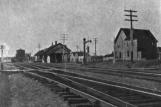 Credits:
Credits:New Brunswick Railway Museum
4
Grand Bay Station20th Century, Circa 1900
Grand Bay, New Brunswick, Canada
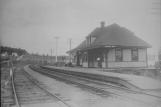 Credits:
Credits:New Brunswick Railway Museum
5
McAdam Station19th Century, Circa 1880
McAdam, New Brunswick, Canada
 Credits:
Credits:New Brunswick Railway Museum
6
McAdam Station20th Century, Circa 1900
McAdam, New Brunswick, Canada
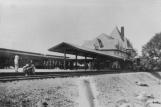 Credits:
Credits:New Brunswick Railway Museum
7
McAdam Station20th Century, Circa 1905
McAdam, New Brunswick, Canada
 Credits:
Credits:New Brunswick Railway Museum
